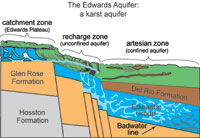Groundwater
Groundwater is water that is found underground in the cracks and spaces in soil and rock. Water is stored within an underground body of rock and can be retrieved for human use. There is a finite supply of water on the Earth, but it is continually recycled naturally.
- Groundwater is the source of 50% of the drinking water in the US and is used at a rate of 90 billion gallons per day.
- Most of the crops in the US are irrigated with groundwater.
What is groundwater?
Groundwater is water that is found underground in the cracks and spaces in soil and rock. Water that is stored underground and can be retrieved for human use is said to be contained within an aquifer. Aquifers can be found in almost any geographic area, however, their productivity can vary greatly. Flux of water in an aquifer is part of the hydrologic cycle. Precipitation and surface water may recharge an aquifer by infiltration through overlying soil and rock. This water can later be released by discharging at springs, lakes, or rivers, or by pumping at wells. Groundwater flow through and near aquifers can dissolve openings in soluble rock, creating caves.
Why is groundwater important?

Although the majority of the Earth’s surface is covered with oceans, seawater is salty and cannot be drunk by humans without extensive treatment. About a third of the freshwater on the planet is locked up in the form of ice, and freshwater in rivers and lakes is easily contaminated and greatly overused in many places. Further, some areas do not have rivers and lakes nearby. In areas such as San Antonio, nearly 100% of the water used is pumped from wells. Nationally, half of the population of the United States drinks groundwater, and most of the crops in the U.S. are irrigated with groundwater.
Groundwater supports a unique array of biota in the caves, springs, and lakes associated with aquifers. Often, these organisms are limited in distribution and are therefore especially vulnerable to changes in the quantity and quality of water in aquifers.
People’s impact on groundwater
Groundwater recharge in some areas can filter water of natural impurities, but in other areas, the rapid rate of infiltration speeds contamination into aquifers. This is true not only of pollutants on the surface, but items we intentionally bury, such as gasoline tanks, septic systems, and landfills. Quick infiltration can carry these contaminants into aquifers, making the water source for many people undrinkable.
The rate of groundwater discharging to the surface naturally is controlled largely by the amount of recharge elsewhere. Humans modify this by pumping groundwater from wells. Areas such as Houston have pumped groundwater faster than it could be replaced, resulting in the permanent lowering of the ground surface. This subsidence damages buildings, roads, and pipelines, and makes areas more prone to flooding. Additionally, over-pumping in coastal areas can cause saltwater intrusion, making the groundwater undrinkable.
Groundwater’s impact on people
Development of cities and transportation patterns was historically controlled by the distribution of surface water, but groundwater certainly played a role. Groundwater discharging at springs served as the center of commerce in some areas. Communities could not exist in the absence of water. Today, development in some areas is regulated to protect our critical water resources.
Future of our groundwater
The future of our groundwater resources depends on the protection of aquifers from pollution and the conservation of water to prevent over-use.